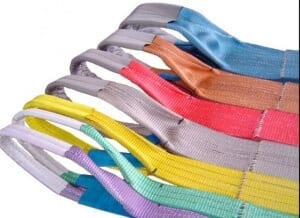Why Use Flat Webbing Slings?
7 December, 2016
Flat webbing slings have their own unique set of benefits as compared to our other offerings of wire ropes. Despite the latter being stronger, flat webbing slings are able to operate in some conditions where wire ropes cannot. In this article, we explore the reasons to use webbing slings over some other offerings.
What are webbing slings?
Webbing slings are a flexible, yet strong alternative to many of the other pieces of lifting equipment on the market. Webbing slings are generally made from polyester and can come in a range of different styles. For example, we stock round slings, poly prop slings, and disposable / one-way slings.
They are able to lift heavy loads, generally up to around 10 tonnes. Webbing slings are handily universally colour coded, which are:
· 1 tonne = purple
· 2 tonnes = green
· 3 tonnes = yellow
· 4 tonnes = grey
· 5 tonnes = red
· 6 tonnes = brown
· 8 tonnes = blue
· 10 tonnes = orange
 The different colour coded flat webbing slings
The different colour coded flat webbing slings
What are the benefits of using flat webbing slings?
Although it may seem like the safer option going for stronger
wire ropes, webbing slings have a number of advantages. For a start, their lightweight nature makes them easy to transport and rig for lifting and lowering your loads.
The fact that it isn’t made from a harsh material, and is instead created using a softer material means that the wire rope won’t scratch or damage the load that it is working with in any way. Despite its lighter nature, it is still able to handle heavy loads and a great deal of pressure. Alongside this, due to their stretch characteristics,
webbing slings are shock absorbent as well and don’t corrode or rust. This means that they won’t weaken with age.
Finally, due to their wide bearing surface, they can easily wrap around and protect the load that they are managing, and as they are flexible webbing slings suffer from minimal twisting or spinning.
How should you protect your webbing sling?
Despite the large number of benefits that webbing slings have, they must still be protected in the right way. Sharp or abrasive surfaces can easily damage them, and they mustn’t be used in temperatures that exceed 194 F. For a full list of guidelines on how to properly store and use your webbing sling, have a look at
Guidance on Safe Sling Use guide.
If you need any more information on webbing slings, then you can get in
contact with us here.
 The different colour coded flat webbing slings
The different colour coded flat webbing slings